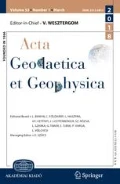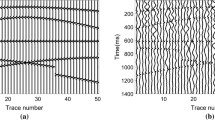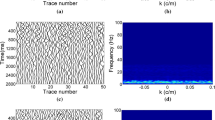Abstract
As one of the major regions of carbonate rock oil–gas exploration in western China, Tazhong area of the Tarim Basin has severe environment and complex ground surface conditions, hence the signal to noise ratio (SNR) of the field seismic data is extremely low. To improve the SNR of desert seismic data is a crucial step in the following work. However, the random noise in desert seismic characterizes by non-stationary, non-gaussian, non-linear and low frequency, which are very different from the random Gaussian noise. In addition, the effective signals of desert seismic generally share the same frequency band with strong random noise. These all make some traditional denoising methods cannot suppress it well. Therefore, a new noise suppression framework based on improved PSO–SVM is proposed in this paper. First, we extract the correlation of noisy desert seismic data to form feature vector. Subsequently, the model of improved PSO–SVM was built to classify the extracted feature, thereby identifying the position of the seismic events. Finally, second-order TGV filter was applied for obtaining denoised results. We perform tests on synthetic and field desert seismic record and the denoising results show that the proposed method can effectively preserve effective signals and eliminate random noise.










Similar content being viewed by others
References
Archana S, Elangovan K (2014) Survey of classification techniques in data mining. Int J Comput Sci Mob Appl 2:65–71
Bekara M, Baan M (2009) Random and coherent noise attenuation by empirical mode decomposition. Geophysics 74:89–98
Bui Quang P, Gaillard P, Cano Y, Ulzibat M (2015) Detection and classification of seismic events with progressive multi-channel correlation and hidden Markov models. Comput Geosci 83:110–119
Dan Z, Yue L, Chao Z (2016) Automatic time picking for microseismic data based on a fuzzy C-means clustering algorithm. IEEE Geosci Remote Sens Lett 13:1900–1904
Deng XY, Yang DH, Yang BJ (2008) LS-SVR with variant parameters and its practical applications for seismic prospecting data denoising. In: IEEE international symposium on industrial electronics, pp 1060–1063
Elboth T, Presterud IV, Hermansen D (2010) Time-frequency seismic data denoising. Geophys Prospect 58(3):441–453
Hongying L, Bingjie C, Zhongmin S et al (2013) Gas and water reservoir differentiation by time-frequency analysis: a case study in southwest China. Acta Geod Geophys 48(4):439–450
Jeng Y, Li YW, Chen CS (2009) Adaptive filtering of random noise in near-surface seismic and ground-penetrating radar data. J Appl Geophys 68(1):36–46
Juan RJ, Francois GM (2011) Machine learning for seismic signal processing: phase classification on a manifold. In: 2011 10th international conference on machine learning and applications and workshops
Jung K, Lee D, Lee J (2010) Fast support-based clustering method for large scale problems. Pattern Recognit 43(5):1975–1983
Jung K, Kim N, Lee J (2011) Dynamic pattern denoising method using multi-basin system with kernels. Pattern Recognit 44(8):1698–1707
Kennedy J, Eberhart R (1995) Particle swarm optimization. In Proceedings of the IEEE international conference on neural networks
Knoll F, Bredies K, Pock T et al (2011) Second order total generalized variation (TGV) for MRI. Magn Resonance Med 65(2):480–491
Li GH, Li Y (2016) Random noise of seismic exploration in desert modeling and its applying in noise attenuation. Chin J Geophys 59(2):682–692 (in Chinese)
Naghizadeh M (2012) Seismic data interpolation and denoising in the frequency-wavenumber domain. Geophysics 77:71–80
Noureddine D, Tahar A, Kamel B, Abdelhafid M, Jalal F (2008) Application of feedback connection artificial neural network to seismic data filtering. Compets Rendus Geosci 340:335–344
Omran MG, Engelbrecht AP, Salman A (2004) Image classification using particle swarm optimization. In: Tan KC, Lim MH, Yao X, Wang L (eds) Recent advances in simulated evolution and learning. Advances in natural computation — Vol 2. World Scientific Publishing Co Pt Ltd, Singapore, pp 347–365. https://doi.org/10.1142/9789812561794_0019
Ristau JP, Moon WM (2001) Adaptive filtering of random noise in 2-D geophysical data. Geophysics 66:342–349
Tian Y, Li Y, Lin H, Wu N (2015) Application of GNMF wavelet spectral unmixing in seismic noise suppression. Chin J Geophys 58(12):4568–4575
Vapnik V (1999) The nature of statistical learning theory. Springer, New York
Vashishtha NJ (2016) Particle swarm optimization based feature selection. Int J Comput Appl 146:11–17
Yuan SY, Wang SX (2013) Edge-preserving noise reduction based on Bayesian inversion with directional difference constraints. J Geophys Eng 10(2):1–10
Zhang C, Li Y, Lin HB, Yang BJ, Wu N (2015) Adaptive threshold based Shearlet transform noise attenuation method for surface microseismic data. In: 77th EAGE conference & exhibition
Zhong T, Zhang S, Li Y, Yang B (2019) Simulation of seismic-prospecting random noise in the desert by a Brownian-motion-based parametric modeling algorithm. CR Geosci 351(1):10–16
Acknowledgements
This research is financially supported by the National Natural Science Foundations of China (Grant No. 41730422).
Author information
Authors and Affiliations
Corresponding author
Rights and permissions
About this article
Cite this article
Li, M., Li, Y., Wu, N. et al. Desert seismic random noise reduction framework based on improved PSO–SVM. Acta Geod Geophys 55, 101–117 (2020). https://doi.org/10.1007/s40328-019-00283-3
Received:
Accepted:
Published:
Issue Date:
DOI: https://doi.org/10.1007/s40328-019-00283-3




